Photos: Kip Miller
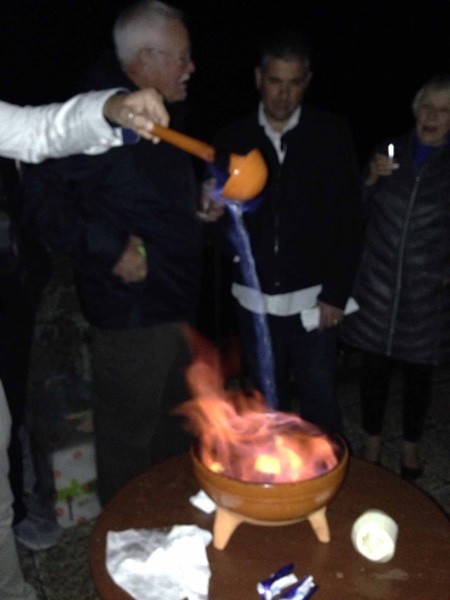
The Queimada ritual is popular throughout Northern Spain.
As sugar burns in the hot liquid, any “witches” present will be purified.
With that Jesús readies a large clay pot which is meant to represent the earth, placing it over a burner. He adds lemon peel, a fistful of coffee beans, a dash of cinnamon and half a cup of sugar. Next comes the key ingredient: an entire bottle or two of Galician Aguardiénte de Orújo, a transparent 50% alcohol brandy made from grape residue. The fiery liquid denotes the tears of Mother Nature. The flame is ignited and Jesús stirs the mixture. In a few minutes the alcohol begins to burn. He scoops up liquid from the bottom of the pot, lifting it high in the air, then pours it back into the pot, creating a cascade of blue fire. As the liquid blazes and the sugar in the pot caramelizes, a special incantation is invoked, beginning with: “Owls, toads and witches….demons, goblins and devils….spirts of the misty vales….” The chant conjures up Satan and Beelzebub’s Inferno and the roar of the enraged sea. As the flame soars, any witches present will be purified. “When the liquid goes down your throat, you will be freed of the evil in your soul,” Jess assures us. By now the night air is turning much colder. I zip up my Parka. The hot liquid feels good, but overpowered by the taste of coffee and cinnamon. I head back to my room and crawl under the covers, ruminating about the occult and the unlucky Maria Bielsa, who had the surname of our parador. In 1499 she was one of the first to be burned at the stake during the Inquisition. She had been accused of witchcraft!

Snow clings to a Pyrenean peak framing rolling green foothills.
But let’s backtrack a couple of days. We are snaking through gorse-covered
foothills above Pamplona, heading east toward Mount Perdido and Ordesa
National Park in the central Pyrenees, to the Parador of Bielsa, our destination
for the next two nights. The Pyrenees form a natural border between Spain
and France, an epic landscape of soft limestone lifted from the seabed
by the action of tectonic plates some fifty million years earlier, tilting
and folding as it rose. Carved further by glaciers, the limestone mass
forged a 270-mile chain of rugged peaks, many above 10,000 feet. ”Near
the park are four ski resorts that are known for their thermal springs.
Skiing here is cheaper and better there than on most European slopes,”
boasts Jesús. “The high Pyrenees are home to wild boars, bears,
deer, chamois goats, and especially rare birds of prey,” he enumerates
as we climb stony hills overlooking the Cinca River. Murky waterfalls
gush down by my bus window, reducing visibility. Cloudy rapids churn on
the river below. A shepherd nudges a herd of sheep that have commandeered
the road to clear a path for our bus. We pass several abandoned hamlets,
each a cluster of grey stone houses encircling a Romanesque church with
bell tower. “Here in the north of Aragon you can buy an entire town
for a pittance,” teases Jesús.
Scaling the
Huesca Pyrenees, we pass by Bielsa, a town that was destroyed during the
Spanish Civil War, but completely rebuilt in local style. It is famous
throughout Spain for a colorful carnival that has been staged there since
antiquity, attracting thousands of visitors each year. “The festival
marks the farewell of winter and the arrival of spring,” Jesús
explains. “Men called trángas dress in goat skins, blacken
their faces, and put potato teeth into their mouths. They also wear ram’s
horns on their heads and goat bells tied around their waists.” Intrigued,
I ask Jesús if I can find a video of the carnival on the Internet.
“For sure, you can, but let me tell more now,” he insists. “The
trángas carry long poles and perform a fertility dance that is
supposed to awaken the earth after the long winter. The crowds cheer and
whistle as they strut through the town, particularly when they beat up
on a couple of bear-skinned characters carrying large sacks of herbs.
All of Bielsa’s unmarried young girls wear colorful regional costumes
and flirt with the trángas. It’s very wild and noisy!”
His words are evocative. I can almost hear trumpets blaring, goat bells
clanging and children screaming as they trail the characters through the
streets! “The carnival celebration on the island of Skyros in Greece
is almost identical,” I tell my husband, quite astounded. “How
is it that two places so far apart came up with a very similar tradition?”
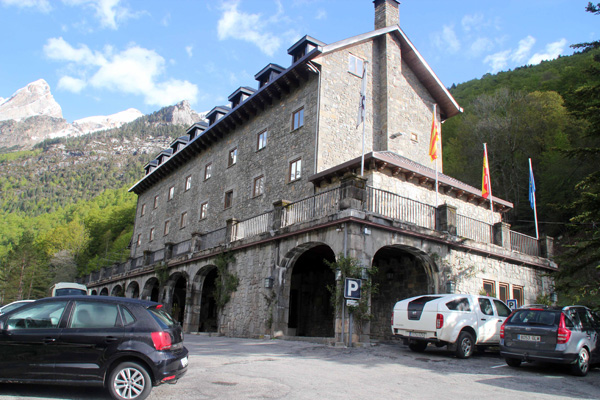
The Parador of Bielsa provides luxurious accommodations at the doorstep of Ordesa National Park.
About eleven kilometers beyond Bielsa, our grey stone parador is a welcome
sight after the long journey. A former hunting lodge, it sits on a sloping,
high meadow surrounded by luxuriant stands of pine and beech overlooking
a fast-moving stream that feeds the Cinca. Above it soars Mount Perdido,
part of the Tris Sorores massif, a sheer mountain trio topping 11,000
feet and among the last remaining glaciers in Europe. It’s a picture
postcard site, even under a light drizzle. We are now on the eastern edge
of Ordesa National Park in the Valle de Pineta, only a few kilometers
and one long tunnel away from the French border. Our traveling companions
Kathy and Eric erupt into a big smile as they survey the setting. “Wow,
we could stay here for the rest of the trip!” Kathy exclaims, being
an ardent fan of mountain hiking. “Tomorrow we’ll get a chance
to explore part of the park,” Jesús assures us.
The parador
is quite elegant, with public rooms featuring exposed beams, fireplaces
and burnished wood floors. One of the finest hotels in the Pyrenees, it
is popular with both mountain trekkers and more sedentary visitors who
appreciate a touch of luxury in such a remote setting. We change for dinner
and our entire group is seated together at two tables in the formal dining
room. Here the kitchen is famed throughout Aragon for regional specialties
featuring game and local fish. And tonight’s menu is no exception:
an appetizer of bread cream with quail egg, and a choice of local trout
with sausage and onion conift or roast lamb a la plancha. The cooking
typifies the attention to detail and authenticity that Spain’s paradores
are known for. “How about if we step outside for a little fresh air
and a peek at Mount Perdido in the dark,” suggests my husband.

Map of Ordesa National Park and Anisclo Canyon, a mighty chasm filled
with cascading waterfalls and lesser rivers that spill into the Cinca.
Early in the morning we start out toward Bielsa, where our group will be divided and loaded onto two mini buses heading southwest through Escalona to Anisclo Canyon. Once unreachable by vehicles, it is accessed by a narrow, one-way loop road that was originally blasted out of the canyon wall by political prisoners during the 1960s. Anisclo is one of the wildest sections of the park, renowned for its cascading waterfalls, botanical riches and animal life. In the lower canyon one encounters dense forests of beech, yew and holm oak. Near its mouth, an ancient limestone grotto houses the hermitage of Saint Úrbez, the patron Saint of shepherds. “Saint Úrbez was born in 702 and there are many legends about him,” says Nathan, our knowledgeable park guide. “Supposedly, Úrbez could to talk to animals, bring on rain and perform other feats of magic. He lived to be 100 and his body remained intact for centuries until it was burned during the Civil War,” he elaborates in a very British accent. “Wow! Nathan’s English is just phenomenal!” I whisper to my husband. “I was educated in Bermuda at an English school,” he winks. “I have been working in Spain for 20 years as a naturalist.”
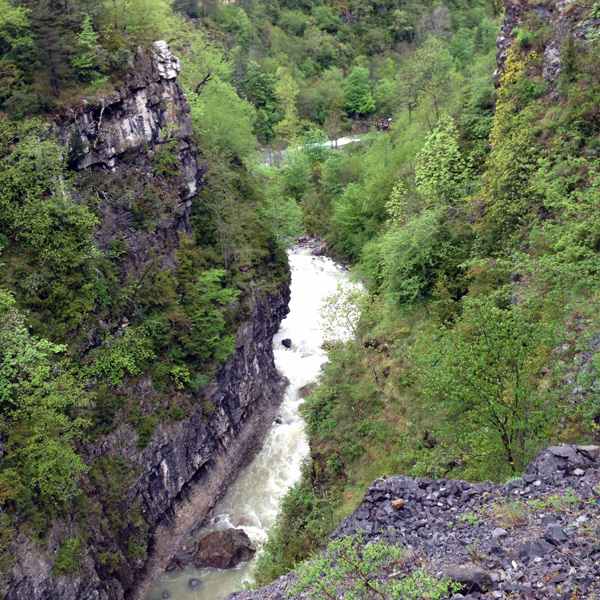
Park naturalist Nathan is an expert on Pyrenean flora, fauna and geologic history.
Anisclo forms a deep chasm in the park that stretches for about ten kilometers,
drained by the Bellos River and feeder streams. Less known to visitors,
it provides a lush contrast to the sere highlands of Monte Perdido. Waterfalls
spill down steep canyon walls at every turn. I stare at the cliffs, their
ancient tectonic folds of iron rich sandstone clearly exposed. “The
canyon is dryer in summer,” Nathan explains as I try to discern the
three sisters of Perdido, Cilindro and Soum de Ramond in the distance
through a stream of water hitting the bus window. “Anisclo plunges
1800 feet and its highest summit rises to 6300 feet,” he continues.
“With so many waterfalls, there is always a flash flood potential
here. The Bellos and other canyon streams flow into the Cinca, which eventually
joins the Ebro. This area has been a UNESCO World Heritage Site since
1967.” We shadow the river for a while longer. The bus makes a stop
by a small bridge near the confluence of the Bellos and the smaller Aso
River. An interpretive sign explains that from here a three-kilometer
loop trail leads to the Úrbez Hermitage. After visiting the cavern,
visitors can cross the Bellos via a modern bridge that overlooks the original
stone-arched bridge. But the weather is not cooperating and our gravel
trail is filled with puddles. “Let’s just take a short walk.
At least you will get a quick taste of the canyon,” Nathan suggests.
“Some
of my favorite mountain flowers are the butterworts,” he notes, pointing
to a purple blossom atop rust-colored rocks. “They are insectivorous
perennials. Their leaves exude a bactericide which helps to decompose
trapped insects. We humans have even used their secretions to treat wounds.”
He approaches a clump of bear’s ear violets, with fuzzy hairs that
absorb water from the atmosphere. Above, pink rock carnations drape a
rocky overhang, not far from wild primroses and a carnivorous flycatcher.
Obviously, Nathan has a well-practiced eye that quickly identifies the
plants. We continue walking for about 20 minutes amid a glistening forest
of Scotch pine and fir that clings to the canyon walls. In some spots
the canyon is quite narrow, almost a slit, with every inch of its light-obscuring
cliffs covered in moss and greenery. Below us, the fast-moving Bellos
churns relentlessly. ”The park has many rare species of birds and
mammals,” adds Nathan. “But it is most famous for its lammergeiers—the
bone-breakers of the Pyrenees. They are Europe’s largest birds, with
a wingspan of over nine feet.” According to local custom, farmers
leave dead animals for them. The birds pick them up with their huge talons,
flying high over rocky pinnacles, and then drop them on the rocks. The
carcasses come apart, their bones broken. The birds swoop down on the
bones, sucking up the exposed marrow.

On the road to AÍnsa, a large herd of sheep commandeers the only paved road.
Our two buses snake up the loop road to leave the park, stopping at a lookout near Fanlo with dramatic views of the surrounding mountain peaks. It is early afternoon and several shepherds are out on the asphalt with their bleating flocks, delaying our descent to Aínsa, one of Spain’s most beautiful and best-preserved medieval towns. Once the capital of the ancient kingdom of Sobrarbe, Aínsa was incorporated into Aragon in the 11th century during the reign of King Garci Ximeno. Our bus deposits us near its historic center overlooking the Cinca and Ara Rivers. The old town includes narrow, cobbled streets and a castle under renovation. “The castle’s largest tower was recently transformed into an eco-museum with an interesting display on Pyrenean vultures,” says Jesus. He leads us to Aínsa’s focal point, the handsome Plaza Mayor, a large central square distinguished by stone arcades filled with shops and restaurants. Here too is the town hall, once the royal palace of the early kings of Aragon. Towering over the square is the belfry of the 11th century Church of Santa Maria.

AÍnsa’s historic Plaza Mayor is dominated by arcades housing communal wine presses,
cafes and the Romanesque church and belfry of Santa Maria.
The plaza is the venue for concerts and civic events, including an international
music festival held every summer. But it is “La Morisma,” a
grand re-enactment of a famous battle waged against the Moors during the
Reconquista that has put Aínsa on the tourist map. “It is
held on even years on the first Sunday in September,” says Jesús.
“Plans for this year’s celebration are already underway. Hundreds
of people are involved.” La Morisma revisits the altercation that
took place during the eighth century, when a burning cross atop a holm
oak was deemed a sign from heaven that the clash against the Moors should
commence. In the lengthy production, costumed soldiers wave their swords
in the air as they confront the Moors. “A king and queen and their
royal entourage watch the festivities from a platform draped with banners,”
Jesús explains. “Among the cast of characters are shepherds,
angels, devils and several allegorical figures who chant heroic poems
accompanied by medieval instruments. The entire town cheers when the king’s
soldiers are victorious in a battle dance,” he adds. This has to
be the most imaginative celebration of Holy Cross Day anywhere in the
world, I decide, hoping to find some excerpts of La Morisma on YouTube.
“What
shall we have for lunch?” asks Eric as he surveys our choices under
the arches, transporting us back to the present. We settle on Pizzeria
La Tea, taking a table in their back room. Here everything is made to
order, Spanish time. But the long wait is worth it -- our thin-crusted
pizzas are heaped with tangy peppers, mushrooms, artichokes and olives,
every bite extra delicious after our canyon trek. We sit back for a few
minutes, polishing off our beers. “What a great day,” sighs
Kathy. “I’m really sorry we have to leave tomorrow. Wouldn’t
it be wonderful to hike through the Ordesa Valley floor?”
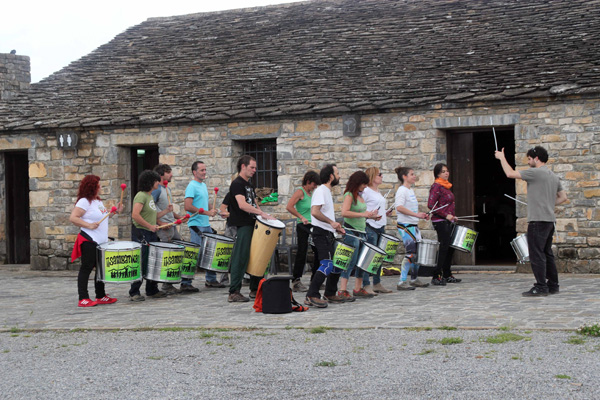
Drummers rehearse for an upcoming music festival in AÍnsa.
We stroll alongside Aínsa’s fortifications. Ahead of us a dozen youths are immersed in a drumming rehearsal, directed by a lead drummer who is the setting the pace. “Could they be practicing for the music festival, or better still for September’s Morisma?” I ask my husband. Not far from the parking area, a small path winds through farm fields to a circular bandstand surrounded by an iron fence. Sheltered inside is a stone reproduction of the oak tree and cross that spurred the great battle of 724. Apparently, the memorial was erected in 1655, the year when the first Morisma was staged.
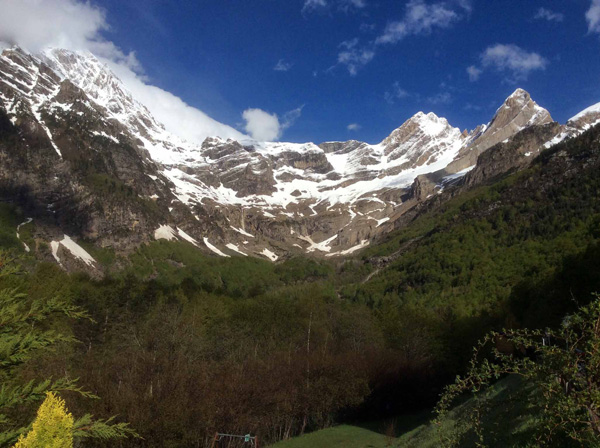
When the rain clears, a bright blue sky defines Mt. Perdido’s glacier.
In recent years, Pyrenean glaciers have been rapidly retreating.
Back on the now-familiar road to our parador, I’m convinced that
in summer this region is totally packed with tourists. The weather has
cleared and Mount Perdido’s glacial peaks are sharply outlined against
a deep blue sky. We take a short hike around the parador, descending to
the stream and a grassy clearing where a black and white cow is grazing
contentedly. A quick nap is restorative after the walk. Later, as we enter
the dining room, I notice that our entire group had the same idea: everyone
looks refreshed and ready for another Pyrenean feast. I savor my bacalao
al ajoarriero, a tangy cod preparation seasoned with garlic and piquillo
peppers, followed by an entrée of veal loin with foie gras. The
dessert is a classic flan, Spain’s delectable version of crème
caramel.
Heading out to Barcelona in the morning, we drive through grassy foothills dotted with impressive Romanesque churches, followed by a series of reservoirs brimming with fresh snowmelt from the Pyrenees. I am filled with regret that our time here was so short. Yet, it was a visit was full of magic, both occult and scenic. I look back at the mountains one last time. In the distance a large vulture is soaring high up in the sky searching for prey, its outstretched wings casting a long shadow on the hills below. I am hoping it is a lammergeier.
